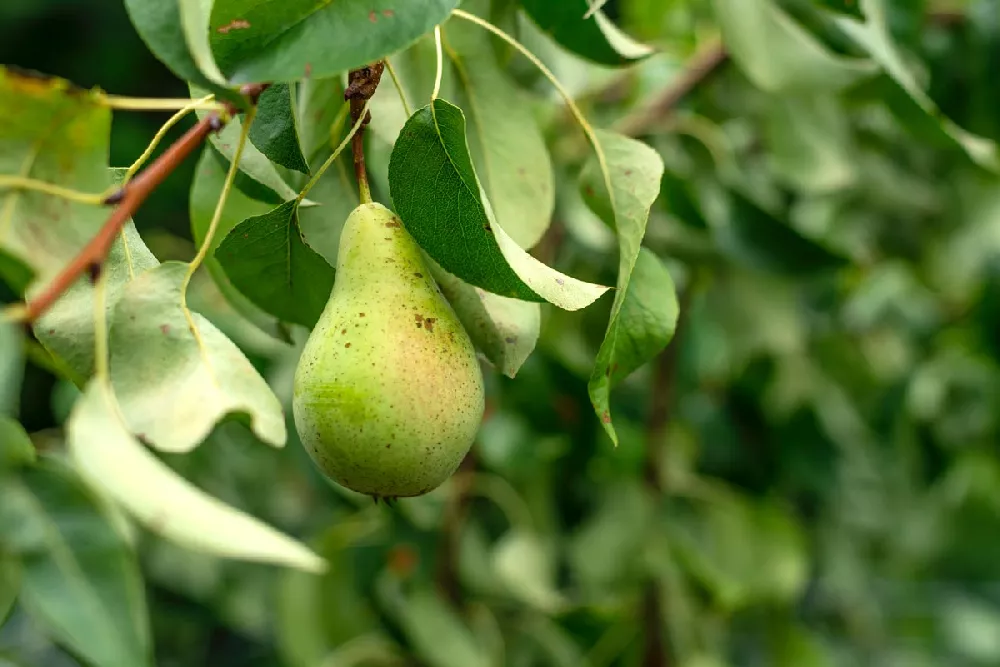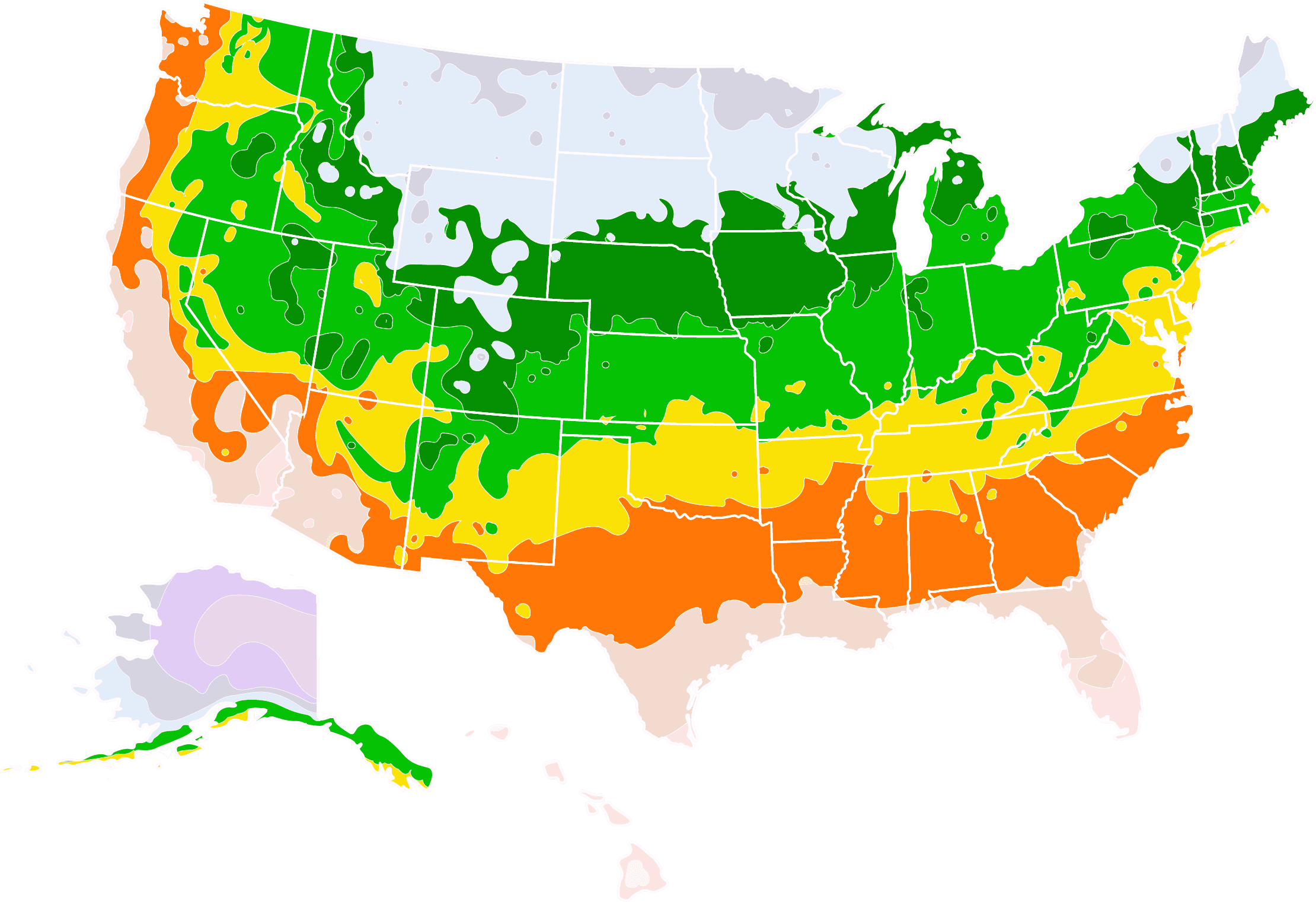- Home >
- Flowers >
- Trees and Plants with White Flowers >
- Seckel Pear Tree
Seckel Pear Tree for Sale - Buying & Growing Guide
Would you like to have a ready source of succulent, sweet, dessert-ready pears in your own yard? If so, consider the Seckel Pear Tree, Pyrus 'Seckel.' So delicious are Seckel Pears that they are often called "sugar pears." This is an older, native pear tree that first appeared in Pennsylvania in the late 18th century. There's good reason for its continued popularity. It's a fairly small tree, reaching a height of 12 to 20 feet, with an attractive, rounded canopy. In spring, it is covered with fragrant white flowers that make it a charming specimen plant. It is resistant to the dreaded fire blight, the scourge of other pear trees, but still needs a little extra care or fussing over. The pears are small but profuse, with bronzed/olive green skin. A dozen of the pears in a wooden bowl would make an excellent centerpiece on a table or mantle. Here are a few more reasons to try this delicious variety:
- Can be espaliered or trained to a trellis.
- An excellent pear for cooking and baking, especially for desserts.
- Fruits can be stored in a cool spot for up to five months.
Enter your zip code to find nearby stores that may carry this plant.
Plant Care
Sunlight

Seckel Pears thrive in full sunlight, at least six to eight hours of direct sunlight a day.
Watering
Give your pear tree about one to two inches of water a week throughout the growing season.
Fertilizing

Fertilize in spring with a balanced, slow-release product designed for fruit trees.
Planting and Care
Planting instructions
Site your Seckel Pear where it will get at least six hours of sunlight a day and in soil that drains well. Unpot your sapling and tease out any encircling roots, which can girdle the tree and slowly kill it. Leave the roots in a bucket of water while you prepare the planting site. Dig a hole that’s as deep as the root ball and two to three times as wide. Place the tree in the hole, spreading out the roots and making sure that it isn’t planted any deeper than it was in the pot. Holding it upright and steady, fill in around the root ball with topsoil, tamping down as you go to eliminate air pockets. Water thoroughly. Apply a two to three-inch layer of organic mulch such as bark chips around the root zone to conserve moisture and hinder weed growth but keep it from touching the trunk to avoid problems with rot.
Watering and nutrients
When newly planted, water your Seckel Pear a few times a week until you begin to see strong signs of growth on the branches. Scale back to watering once a week, giving the tree one to two inches of water at a time. In very hot or dry weather, increase your watering. After your first frost in fall, you can stop watering during the winter months. To fertilize, use a product that is designed for fruit trees, applying it as the package directs in spring and throughout the growing season.
Pollination
The honeybee is the most common pollinator of pear trees, though other insects may also be drawn to the tree’s flowers. Pear trees are not self-fertile, meaning that in order to have a bountiful harvest, you’ll need more than one variety of pear planted nearby. Good pollinators for the Seckel Pear are the Bosc Pear, D’Anjou Pear and Comice Pear trees.
Pruning
Remove dead, diseased or damaged branches whenever you see them. In early spring, before bud break, prune back your pear tree to shape it. The tree grows best when it has a strong central leader (trunk), surrounded by lateral branches that are spaced evenly four to six inches apart around the trunk. Cut back about a fourth of these lateral branches every year. If your tree bears heavily, you may also prune out some of the excess fruit to allow the tree to concentrate on the ones remaining. Leave two fruits per cluster.
Pests, diseases and animals
Pests that may appear on pear trees include scale insects, leafrollers and aphids. A healthy tree can handle minor infestations fine on its own, but if insect pressure is high, consider releasing beneficial insects such as aphids and lacewings to attack the pests. Use insecticides as a last resort. Diseases of the pear include Septoria leaf spot and leaf and stem blight. A copper fungicide may be helpful in dealing with these fungal diseases. When your tree is bearing fruit, you may see signs of small animal damage, but this will mostly be on fallen fruit.
Harvesting
Unlike many fruits, pears are picked when they are still unripe. Look for the fruit to begin to take on its mature greenish-bronze color. If they are ready, they will separate from the branch easily. Place them in a warm spot to ripen—or better yet, try one to see if it’s already ripe enough to eat. Pears are also easily stored for the winter, in a cold, humid spot that is 32 to 40 degrees Fahrenheit.
Achieving maximum results
Fruit trees have a reputation for being high-maintenance, but this doesn’t have to be the case. Commercial fruit growers may spray their trees frequently and coddle them to ensure maximum results, but you can achieve much the same thing in your backyard with little work. Pruning, for example, is not difficult. Pear trees like a central trunk, which is easy to achieve just by pruning out secondary vertical branches. If the secondary branches are so numerous that the tree looks cluttered, trim them back. Always try to prune lateral branches to an outward-facing bud and make your cut at a 45-degree angle, using clippers that are clean and have been sterilized with rubbing alcohol.
FAQs
Where can I grow Seckel Pear trees?
Seckel Pears are hardy down to -10 degrees Fahrenheit and can be grown as far north as coastal New England and most of the Pacific Northwest. They don't do well in sub-tropical areas of the south but will thrive even in northern Florida and much of Texas. If you live in USDA hardiness zones five through eight, then you should have no problem growing a Seckel Pear.
Can Seckel Pears be container-grown?
Yes, they can, although they will not grow as tall as a tree that is grown in the soil. Choose a pot for your pear tree that is roughly twice the size of the root ball with good drainage holes in the bottom. Use a good-quality potting mix and plant as per our directions above. Keep in mind that container-grown plants may need more frequent feeding and watering than those in your yard and may need to be replanted and refreshed every few years.
How big do Seckel Pear trees get?
The Seckel Pear is a medium-sized tree that maxes out anywhere from 12 to 20 feet, with a mature canopy that is 12 to 13 feet wide. Keep the width in mind if you are planting your tree near your home or another structure, planting it at least six to seven feet away from the foundation. A pot-grown Seckel Pear is unlikely to grow taller than six to seven feet since the roots are constrained by the container.
Compare Similar Products
You can't add more Product Name - Product size to the cart.
OK








